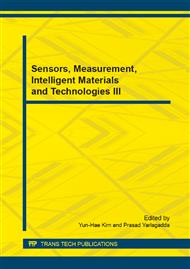[1]
D. H. Sun, T. Zhou, W. N. Liu, M. Zhao, H. M. Li, The backward looking, effect in lattice hydrodynamic model of pedestrian flow, Journal of Information & Computational Science. 10(2003) 1-8.
Google Scholar
[2]
M. Bando, K. Hasebe, A. Nakayama, A. Shibata,Y. Sugiyama, Dynamical model of traffic congestion and numerical simulation, Physical Review E. 51(1995), 1035-1042.
DOI: 10.1103/physreve.51.1035
Google Scholar
[3]
D. Helbing, B. Tilch, Generalized force model of traffic dynamics, Physical Review E. 58(1998), 133-138.
DOI: 10.1103/physreve.58.133
Google Scholar
[4]
Y. Xue, Analysis of the stability and density waves for traffic flow, Chinese Physics B. 11(2002) 1128-1134.
Google Scholar
[5]
M. Treiber, A. Hennecke, D. Helbing, Derivation, properties, and simulation of a gas-kinetic- based nonlocal traffic model, Physical Review E, 59(1999), 239-253.
DOI: 10.1103/physreve.59.239
Google Scholar
[6]
R. Jiang, Q. S. Wu, Z. J. Zhu, Full velocity difference model for a car-following theory. Phys Rev E, 64( 2001) 017101/1-017101/4.
Google Scholar
[7]
G. H. Peng, X. H. Cai, C. Q. Liu, B. F. Cao, M. X. Tuo, Optimal velocity difference model for a car-following theory, Physics letters A. 375(2011) 3973-3977.
DOI: 10.1016/j.physleta.2011.09.037
Google Scholar
[8]
H. X. Ge, S. Q. Dai, Y. Xue, L. Y. Dong, Stabilization analysis and modified Korteweg-de Vries equation in a cooperative driving system, Physical Review E. 71(2005), 066119-066125.
DOI: 10.1103/physreve.71.066119
Google Scholar
[9]
S. W. Yu, Q. L. Liu, X. H. Li. Full velocity difference and acceleration model for a car-following theory, Communication in Nonlinear Science Numerical Simulation. 18(2013), 1229-1234.
DOI: 10.1016/j.cnsns.2012.09.014
Google Scholar
[10]
T. Wang, Z. Y. Gao, X. M. Zhao, Multiple velocity difference model and its stability analysis, Acta Physica Sinica. 55(2006), 634–640.
Google Scholar


